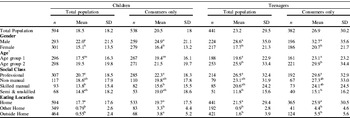Regular consumption of wholegrain foods has been associated with a number of health benefits including a reduced risk of developing cardiovascular disease and certain cancers(Reference Jonnalagadda, Harnack and Liu1). However, information on wholegrain intakes in the Irish population is lacking. The aim of this study was to quantify wholegrain intakes in a representative sample of Irish children and teenagers using the National Children's Food Survey (NCFS; ages 5–12 years, n 594) and the National Teen's Food Survey (NTFS; ages 13–17 years, n 441) (www.iuna.net). Both surveys examined habitual food and beverage consumption using a 7 day food diary. Brand information, including ingredient listings, was subsequently recorded in the Irish National Food Ingredient Database (INFID(Reference Gilsenan, Lambe and Gibney2)), with each brand linked to consumption data. In the current analysis, the presence or absence of wholegrain was confirmed at food and brand level, and information on the grain ingredients present were ascribed using food package labelling, comparable products and recipe databases specific for the NCFS and NTFS.

† Age group 1: 5–8 years (NCFS) 13–14 years (NTFS), Age group 2: 9–12 years (NCFS) 15–17 years (NTFS).
abDifferent uppercase superscript letters indicate mean differences within each factor at P<0.05.
Mean intakes (g/day) of wholegrain were 18.5 and 23.2 for children and teenagers respectively, rising to 20.5 and 26.9 in consumers only. 90.5% of Irish children and 86.6% of Irish teenagers consumed wholegrain. Wheat sources provided>65% of all wholegrain intake, with ready to eat breakfast cereals providing the greatest contribution to wholegrain intakes for children and teenagers (59.3, 44.3%), followed by bread and rolls (14.4, 26.5%). Although, 94.5% of children and 85.3% of teenagers were not meeting wholegrain recommendations.(3), wholegrain consumers had significantly higher intakes of fibre, phosphorus and magnesium in comparison to non-consumers of wholegrain. The present study shows that although wholegrain is widely consumed by Irish children and teenagers, actual intakes are below recommended levels.
This analysis was funded by Cereal Partners Worldwide.





